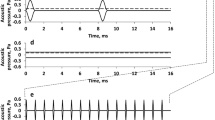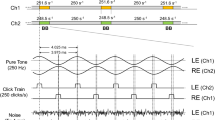Summary
The complex of five waves, which are the responses to click stimuli of the auditory nerve and the brainstem auditory nuclei, were recorded in ten human subjects by means of earlobe and scalp electrodes. The rate of the stimuli was varied from 5/s to 80/s and their intensity was varied over a 70 dB intensity range in order to study the rate and intensity functions of each of the response components. With increasing click intensity, the amplitude of the first wave (generated by the auditory nerve) increased proportionally while the amplitudes of the later waves (generated by the brainstem auditory nuclei) reached their maximum amplitudes at intermediate click levels (saturation), and at high intensities occasionally even decreased in amplitude. The latency of each of the waves decreased by similar amounts as the intensity was increased. With increasing click rates, the amplitude of the first wave decreased the most, while there were smaller effects on the amplitude of the later waves. There was no effect of click rate on the latency of the first wave, but the latency of the later waves increased with click rate, the effect being greater on the later waves. In the rate functions, the latency change of a wave was greater than that of the waves preceding it (accumulative effect). These results are explained by overlapping convergence and divergence in the ascending auditory pathway. These results support the notion that the principal component of each wave is activated by the principal component of the previous wave. These results may explain the relative ease with which several workers record the fourth wave of the complex, and their preference for this response.
Similar content being viewed by others
References
Aran, J. M.: The electrocochleogram, recent results in children and in some pathological cases. Arch. klin. exp. Ohr.-, Nas.- u. Kehlk.-Heilk. 198, 128–141 (1971)
Buchwald, L. S., Huang, C. H.: Far field acoustic response: Origins in the cat. Science 189, 382–384 (1975)
Chow, K. L.: Numerical estimates of the auditory central nervous system of the rhesus monkey. J. Comp. Neurol. 95, 159–175 (1951)
Coats, A. C.: Nonsurgical recording of human auditory nerve action potentials and cochlear microphonics. Annals Otol. 79, 844–852 (1970)
Cullen, J. K., Ellis, M. S., Berlin, C. I., Lousteau, R. J.: Human acoustic nerve action potential recordings from the tympanic membrane without anesthesia. Acta Otol. 74, 15–22 (1972)
Eggermont, J. J., Odenthal, D. W., Schmidt, P. H. Spoor, A.: Electrocochleography. Basic principles and clinical application. Acta oto-laryng. (Stockh.) Suppl. 316 (1974)
Gerull, G., Giesen, M., Mrowinski, D., Rudolph, N.: Properties of an early AER of 5–10 msec latency. Rev. Laryngol. 95, 560–565 (1974)
Hecox, K., Galambos, R.: Brainstem auditory evoked responses in human infants and adults. Arch. Otolaryngol. 99, 30–33 (1974)
Humphries, K., Ashcroft, P., Douek, E.: Personal communication (1975)
Jewett, D., Romano, H. N., Williston, J. S.: Human auditory evoked responses: Possible brainstem components detected on the scalp. Science 167, 1517–1518 (1970)
Jewett, D. L., Williston, J. S.: Auditory-evoked far fields averaged from the scalp of humans. Brain 94, 681–696 (1971)
Kiang, N. Y. S.: Discharge patterns of single fibres in the cats' auditory nerve. Research Monograph, no. 35. The M.I.T. Press, Cambridge, Mass. (1965)
Lev, A., Sohmer, H.: Sources of averaged neural responses recorded in animal and human subjects during cochlear audiometry. Arch. klin. exp. Ohr.-, Nas.- u. Kehlk.-Heilk. 201, 79–90 (1972)
Lieberman, A., Sohmer, H., Szabo, G.: Standard values of amplitude and latency of cochlear audiometry (electro-cochleography) responses in different age groups. Arch. klin. exp. Ohr.-, Nas.-u. Kehlk.-Heilk. 203, 267–273 (1973)
Martin, J. L., Coats, A. C.: Short-latency auditory evoked responses recorded from human nasopharynx. Brain Res. 60, 496–502 (1973)
Megill, N. D., Kahn, A. R., Peake, W. J., Kiang, N. Y. S.: Recording auditory-nerve potentials as an office procedure. Ann. Otol. Rhin. Laryngol. 84, 2–10 (1975)
Picton, T. W., Hillyard, S. A., Krausz, H. I., Galambos, R.: Human auditory evoked potentials. I: Evaluation of components. Electroenceph. clin. Neurophysiol. 36, 179 (1974)
Portman, M., Aran, J. M., LeBert, G.: Electrocochleogramme humain en dehors de toute intervention chirurgicale. Acta oto-laryng. (Stockh.) 65, 105–114 (1968)
Salomon, G., Elberling, C.: Cochlear nerve potentials recorded from the ear canal in man. Acta Otolaryng. (Kbh.) 71, 319–325 (1971)
Sohmer, H., Feinmesser, M.: Cochlear action potentials recorded from the external ear in man. Annals Otol. Rhin. Laryng. 76, 427–435 (1967)
Sohmer, H., Feinmesser, M.: Routine use of electrocochleography (Cochlear audiometry) on human subjects. Audiol. 12, 167–173 (1973)
Sohmer, H., Feinmesser, M., Szabo, G.: Sources of electrocochleographic responses as studied in patients with brain damage. Electroenceph. clin. Neurophysiol. 37, 663–669 (1974)
Sohmer, H., Pratt, H.: Electrocochleography during noise-induced temporary threshold shifts. Audiol. 14, 130–134 (1975)
Starr, A.: Clinical relevance of auditory brainstem responses in brainstem disorders in man. Clinical evoked responses, ed. Desmedt (in press) (1975)
Stecker, M.: Einfluß der Click-Flankensteilheit auf die frühen Reizantworten des Hörsystems. Arch. Oto-Rhin. Laryngol. 206, 225–234 (1974)
Stephens, S. D. G., Hyde, M. S., Thornton, A. R. D.: Personal communication (1975)
Stillman, R. D., Moushegian, G., Rupert, A. L.: Early tone-evoked responses in normal and hearingimpaired subjects. Audiol. (in press) (1975)
Suzuki, T., Horiuchi, K., Koizumi, S.: Auditory brainstem response and its application to objective audiometry. Abstract 8, part 2, p. 2–3. Jap. Journ. Otol. 77, 587 (1974)
Terkildsen, K., Osterhamel, P., Huisin't Veld, F.: Electrocochleography with a far field technique. Scand. Audiol. 2, 141–148 (1973)
Thornton, A. R. D.: The diagnostic potential of surface recorded electrocochleography. British J. Audiol. 9, 7–13 (1975a)
Thornton, A. R. D.: Statistical properties of surface recorded electrocochleographic responses. Scand. Audiol. 4, 91–103 (1975b)
Yoshie, N.: Auditory nerve action potential responses to clicks in man. Laryngoscope (St. Louis) 28, 198–215 (1968)
Author information
Authors and Affiliations
Rights and permissions
About this article
Cite this article
Pratt, H., Sohmer, H. Intensity and rate functions of cochlear and brainstem evoked responses to click stimuli in man. Arch Otorhinolaryngol 212, 85–92 (1976). https://doi.org/10.1007/BF00454268
Received:
Issue Date:
DOI: https://doi.org/10.1007/BF00454268




